Developing a Novel Fermented Milk with Anti-Aging and Anti-Oxidative Properties Using Lactobacillus kefiranofaciens HL1 and Lactococcus lactis APL015
Abstract
1. Introduction
2. Materials and Methods
2.1. Bacterial Strains and Culture Conditions
2.2. Preparation of Fermented Milk
2.3. Microbial Viability and Product Analysis
2.4. Animal Study Design
2.5. Behavioral Testing
2.6. Biochemical Analysis
2.7. Statistical Analysis
3. Results
3.1. Fermentation Performance and Probiotic Viability in Co-Culture
3.2. Physical and Sensory Properties of the Fermented Milk
3.3. Anti-Aging Effects in D-Galactose-Induced Aging Mice
3.3.1. Behavioral Improvements in Learning and Memory
3.3.2. Oxidative Stress and Inflammatory Biomarkers
3.3.3. Modulation of Gut Microbiota and SCFA Production
4. Discussion
5. Conclusions
Author Contributions
Funding
Institutional Review Board Statement
Informed Consent Statement
Data Availability Statement
Acknowledgments
Conflicts of Interest
Abbreviations
| APL15 | Lactococcus lactis subsp. cremoris APL015 |
| FM | co-cultured fermented milk |
| SCFA | short-chain fatty acid |
References
- Tenchov, R.; Sasso, J.M.; Wang, X.; Zhou, Q.A. Aging Hallmarks and Progression and Age-Related Diseases: A Landscape View of Research Advancement. ACS Chem. Neurosci. 2024, 15, 1–30. [Google Scholar] [CrossRef]
- Jiang, Q.; Liu, J.; Huang, S.; Wang, X.Y.; Chen, X.; Liu, G.H.; Ye, K.; Song, W.; Masters, C.L.; Wang, J.; et al. Antiageing Strategy for Neurodegenerative Diseases: From Mechanisms to Clinical Advances. Signal Transduct. Target. Ther. 2025, 10, 76. [Google Scholar] [CrossRef]
- Qian, Y.; Zhang, J.; Zhou, X.; Yi, R.; Mu, J.; Long, X.; Pan, Y.; Zhao, X.; Liu, W. Lactiplantibacillus plantarum CQPC11 Isolated from Sichuan Pickled Cabbages Antagonizes D-Galactose-Induced Oxidation and Aging in Mice. Molecules 2018, 23, 3026. [Google Scholar] [CrossRef]
- Zeng, X.; Jia, H.; Zhang, X.; Wang, X.; Wang, Z.; Gao, Z.; Yuan, Y.; Yue, T. Supplementation of Kefir Ameliorates Azoxymethane/Dextran Sulfate Sodium Induced Colorectal Cancer by Modulating the Gut Microbiota. Food Funct. 2021, 12, 11641–11655. [Google Scholar] [CrossRef]
- Schicho, R.; Krueger, D.; Zeller, F.; von Weyhern, C.W.; Frieling, T.; Kimura, H.; Ishii, I.; De Giorgio, R.; Campi, B.; Schemann, M. Hydrogen Sulfide is a Novel Prosecretory Neuromodulator in the Guinea-Pig and Human Colon. Gastroenterology 2006, 131, 1542–1552. [Google Scholar] [CrossRef]
- Sobko, T.; Huang, L.; Midtvedt, T.; Norin, E.; Gustafsson, L.E.; Norman, M.; Jansson, E.A.; Lundberg, J.O. Generation of NO by Probiotic Bacteria in the Gastrointestinal Tract. Free Radic. Biol. Med. 2006, 41, 985–991. [Google Scholar] [CrossRef]
- Akbari, E.; Asemi, Z.; Daneshvar Kakhaki, R.; Bahmani, F.; Kouchaki, E.; Tamtaji, O.R.; Hamidi, G.A.; Salami, M. Effect of Probiotic Supplementation on Cognitive Function and Metabolic Status in Alzheimer’s Disease: A Randomized, Double-Blind and Controlled Trial. Front. Aging Neurosci. 2016, 8, 256. [Google Scholar] [CrossRef]
- Georgalaki, M.; Zoumpopoulou, G.; Anastasiou, R.; Kazou, M.; Tsakalidou, E. Lactobacillus kefiranofaciens: From Isolation and Taxonomy to Probiotic Properties and Applications. Microorganisms 2021, 9, 2158. [Google Scholar] [CrossRef]
- Chen, H.C.; Wang, S.Y.; Chen, M.J. Microbiological Study of Lactic Acid Bacteria in Kefir Grains by Culture-Dependent and Culture-Independent Methods. Food Microbiol. 2008, 25, 492–501. [Google Scholar] [CrossRef]
- Ho, S.T.; Hsieh, Y.T.; Wang, S.Y.; Chen, M.J. Improving Effect of a Probiotic Mixture on Memory and Learning Abilities in D-Galactose–Treated Aging Mice. J. Dairy Sci. 2019, 102, 1901–1909. [Google Scholar] [CrossRef]
- Ho, S.T.; Hsieh, Y.T.; Chen, M.J. Probiotic Strains Mixture Pm1 and Lactobacillus kefiranofaciens Attenuated D-Galactose-Induced Oxidative Stress and Brain Damage in Mice Model. In Proceedings of the 9th Asian Conference on Lactic Acid Bacteria, Gwangju, Republic of Korea, 3–5 July 2017. [Google Scholar]
- Cheirsilp, B.; Radchabut, S. Enhanced kefiran production by mixed culture of Lactobacillus kefiranofaciens and Saccharomyces cerevisiae. J. Biotechnol. 2003, 100, 43–53. [Google Scholar] [CrossRef]
- de Souza, M.; Drunkler, D.A.; Colla, E. Probiotic Functional Yogurt: Challenges and Opportunities. Fermentation 2024, 10, 6. [Google Scholar] [CrossRef]
- Oliveira, R.P.S.; Florence, A.C.R.; Silva, R.C.; Perego, P.; de Oliveira, M.N.; Converti, A. Growth, Organic Acids Profile and Sugar Metabolism of Bifidobacterium lactis in Co-Culture with Streptococcus thermophilus: The Inulin Effect. Food Res. Int. 2012, 48, 21–27. [Google Scholar] [CrossRef]
- Ranadheera, C.S.; Baines, S.K.; Adams, M.C.; Day, L. Co-Culturing of Probiotics Influences the Microbial and Physico-Chemical Properties but Not Sensory Quality of Fermented Dairy Drink Made from Goat’s Milk. Small Rumin. Res. 2016, 136, 104–108. [Google Scholar] [CrossRef]
- Nakajima, H.; Suzuki, Y.; Kaizu, H.; Hirota, T. Cholesterol-Lowering Activity of Ropy Fermented Milk. J. Food Sci. 1992, 57, 1327–1329. [Google Scholar] [CrossRef]
- Slacanac, V.; Božanić, R.; Hardi, J.; Rezessyné Szabó, J.; Lučan, M.; Krstanović, V. Nutritional and Therapeutic Value of Fermented Caprine Milk. Int. J. Dairy Technol. 2010, 63, 171–189. [Google Scholar] [CrossRef]
- Hill, C.; Guarner, F.; Reid, G.; Gibson, G.R.; Merenstein, D.J.; Pot, B.; Morelli, L.; Canani, R.B.; Flint, H.J.; Salminen, S.; et al. The International Scientific Association for Probiotics and Prebiotics consensus statement on the scope and appropriate use of the term probiotic. Nat. Rev. Gastroenterol. Hepatol. 2014, 11, 506–514. [Google Scholar] [CrossRef]
- Segers, M.E.; Lebeer, S. Towards a better understanding of Lactobacillus rhamnosus GG–host interactions. Microb. Cell Fact. 2014, 13 (Suppl. S1), S7. [Google Scholar] [CrossRef]
- Suda, K.; Kato, T.; Shimizu, K.; Matsuki, T.; Takada, M.; Miyazaki, K. Fermented milk containing Lactobacillus casei strain Shirota prevents the onset of physical symptoms in medical students under academic examination stress. Benef. Microbes 2016, 7, 153–156. [Google Scholar] [CrossRef]
- Grand View Research. Probiotics Market Size, Share & Trends Analysis Report by Ingredient (Bacteria, Yeast), by Application (Food & Beverages, Dietary Supplements), by End-User, by Distribution Channel, by Region, and Segment Forecasts, 2024–2030. 2023. Available online: https://www.grandviewresearch.com/industry-analysis/probiotics-market (accessed on 18 July 2025).
- Ng, K.S.; Chang, Y.C.; Chen, Y.P.; Lo, Y.H.; Wang, S.Y.; Chen, M.J. Characterization of exopolysaccharide-producing lactic acid bacteria from Taiwanese ropy fermented milk and their application in low-fat fermented milk. Anim. Biosci. 2022, 35, 281–289. [Google Scholar] [CrossRef]
- Wang, S.Y.; Chen, Y.P.; Huang, R.F.; Wu, Y.L.; Ho, S.T.; Li, K.Y.; Watanabe, K.; Chen, M.J. Subspecies classification and comparative genomic analysis of Lactobacillus kefiranofaciens HL1 and M1 for potential niche-specific genes and pathways. Microorganisms 2022, 10, 1637. [Google Scholar] [CrossRef]
- Wang, S.Y.; Huang, R.F.; Ng, K.S.; Chen, Y.P.; Shiu, J.S.; Chen, M.J. Co-Culture Strategy of Lactobacillus kefiranofaciens HL1 for Developing Functional Fermented Milk. Foods 2021, 10, 2098. [Google Scholar] [CrossRef]
- Nitta, A.; Murai, R.; Suzuki, N.; Ito, H.; Nomoto, H.; Katoh, G.; Furukawa, Y.; Furukawa, S. Diabetic Neuropathies in Brain Are Induced by Deficiency of BDNF. Neurotoxicol. Teratol. 2002, 24, 695–701. [Google Scholar] [CrossRef]
- Bromley-Brits, K.; Deng, Y.; Song, W. Morris Water Maze Test for Learning and Memory Deficits in Alzheimer’s Disease Model Mice. J. Vis. Exp. 2011, 53, 2920. [Google Scholar] [CrossRef]
- Rodriguez, A.; Zhang, H.; Klaminder, J.; Brodin, T.; Andersson, M. ToxId: An Algorithm to Track the Identity of Multiple Animals. Sci. Rep. 2017, 7, 14774. [Google Scholar] [CrossRef]
- Rodriguez, A.; Zhang, H.; Klaminder, J.; Brodin, T.; Andersson, P.L.; Andersson, M. ToxTrac: A Fast and Robust Software for Tracking Organisms. Methods Ecol. Evol. 2018, 9, 460–464. [Google Scholar] [CrossRef]
- Rinttilä, T.; Kassinen, A.; Malinen, E.; Krogius, L.; Palva, A. Development of an Extensive Set of 16S rDNA-Targeted Primers for Quantification of Pathogenic and Indigenous Bacteria in Faecal Samples by Real-Time PCR. J. Appl. Microbiol. 2004, 97, 1166–1177. [Google Scholar] [CrossRef]
- Matsuda, K.; Tsuji, H.; Asahara, T.; Kado, Y.; Nomoto, K. Sensitive Quantitative Detection of Commensal Bacteria by rRNA-Targeted Reverse Transcription-PCR. Appl. Environ. Microbiol. 2007, 73, 32–39. [Google Scholar] [CrossRef]
- Kikuchi, E.; Miyamoto, Y.; Narushima, S.; Itoh, K. Design of Species-Specific Primers to Identify 13 Species of Clostridium Harbored in Human Intestinal Tracts. Microbiol. Immunol. 2002, 46, 353–358. [Google Scholar] [CrossRef]
- Torii, T.; Kanemitsu, K.; Wada, T.; Itoh, S.; Kinugawa, K.; Hagiwara, A. Measurement of Short-Chain Fatty Acids in Human Faeces Using High-Performance Liquid Chromatography: Specimen Stability. Ann. Clin. Biochem. 2010, 47, 447–452. [Google Scholar] [CrossRef]
- Poulsen, V.K.; Moghadam, E.G.; Kračun, S.K.; Svendsen, B.A.; Nielsen, W.M.; Oregaard, G.; Krarup, A. Versatile Lactococcus lactis Strains Improve Texture in Both Fermented Milk and Soybean Matrices. FEMS Microbiol. Lett. 2022, 369, fnac117. [Google Scholar] [CrossRef]
- Ng, K.S.; Wang, S.Y.; Chen, M.J. A Novel Immobilized Cell System Involving Taiwanese Kefir Microorganisms and Sugar Cane Pieces for Fermented Milk Production. J. Dairy Sci. 2020, 103, 141–149. [Google Scholar] [CrossRef]
- Heurtaux, T.; Bouvier, D.S.; Benani, A.; Helgueta Romero, S.; Frauenknecht, K.B.M.; Mittelbronn, M.; Sinkkonen, L. Normal and Pathological NRF2 Signalling in the Central Nervous System. Antioxidants 2022, 11, 1426. [Google Scholar] [CrossRef]
- Feng, T.; Wang, J. Oxidative Stress Tolerance and Antioxidant Capacity of Lactic Acid Bacteria as Probiotic: A Systematic Review. Gut Microbes 2020, 12, 1801944. [Google Scholar] [CrossRef]
- Rezaie, N.; Aghamohammad, S.; Gholizadeh Khiavi, E.H.A.; Pourshafie, M.R.; Talebi, M.; Rohani, M. Comparison of Novel Native Probiotics and Paraprobiotics in Modulating Oxidative Stress and Inflammation in DSS-Induced Colitis: Implications for Enhanced Therapeutic Strategies in High Fat Diet. BMC Immunol. 2024, 25, 85. [Google Scholar] [CrossRef]
- Loh, J.S.; Mak, W.Q.; Tan, L.K.S.; Ng, C.X.; Chan, H.H.; Yeow, S.H.; Foo, J.B.; Ong, Y.S.; How, C.W.; Khaw, K.Y. Microbiota-Gut-Brain Axis and Its Therapeutic Applications in Neurodegenerative Diseases. Signal Transduct. Target. Ther. 2024, 9, 37. [Google Scholar] [CrossRef]
- Camargo, A.; Ramírez, J.D.; Kiu, R.; Hall, L.J.; Muñoz, M. Unveiling the Pathogenic Mechanisms of Clostridium perfringens Toxins and Virulence Factors. Emerg. Microbes Infect. 2024, 13, 2341968. [Google Scholar] [CrossRef]
- Cavaliere, G.; Catapano, A.; Trinchese, G.; Cimmino, F.; Penna, E.; Pizzella, A.; Cristiano, C.; Lama, A.; Crispino, M.; Mollica, M.P. Butyrate Improves Neuroinflammation and Mitochondrial Impairment in Cerebral Cortex and Synaptic Fraction in an Animal Model of Diet-Induced Obesity. Antioxidants 2022, 12, 4. [Google Scholar] [CrossRef]
- Peng, L.; Li, Z.R.; Green, R.S.; Holzman, I.R.; Lin, J. Butyrate Enhances the Intestinal Barrier by Facilitating Tight Junction Assembly via Activation of AMP-Activated Protein Kinase in Caco-2 Cell Monolayers. J. Nutr. 2009, 139, 1619–1625. [Google Scholar] [CrossRef]
- Wibowo, H.; Harbuwono, D.S.; Tahapary, D.L.; Kartika, R.; Pradipta, S.; Larasati, R.A. Impact of Sodium Butyrate Treatment in LPS-Stimulated Peripheral Blood Mononuclear Cells of Poorly Controlled Type 2 DM. Front. Endocrinol. 2021, 12, 652942. [Google Scholar] [CrossRef]
- Wang, X.; Duan, C.; Li, Y.; Lu, H.; Guo, K.; Ge, X.; Chen, T.; Shang, Y.; Liu, H.; Zhang, D. Sodium Butyrate Reduces Overnutrition-Induced Microglial Activation and Hypothalamic Inflammation. Int. Immunopharmacol. 2022, 111, 109083. [Google Scholar] [CrossRef]
- Nagpal, R.; Neth, B.J.; Wang, S.; Craft, S.; Yadav, H. Modified Mediterranean-Ketogenic Diet Modulates Gut Microbiome and Short-Chain Fatty Acids in Association with Alzheimer’s Disease Markers in Subjects with Mild Cognitive Impairment. EBioMedicine 2019, 47, 529–542. [Google Scholar] [CrossRef]
- Qian, X.H.; Xie, R.Y.; Liu, X.L.; Chen, S.D.; Tang, H.D. Mechanisms of Short-Chain Fatty Acids Derived from Gut Microbiota in Alzheimer’s Disease. Aging Dis. 2022, 13, 1252–1266. [Google Scholar] [CrossRef]
- Jurášková, D.; Ribeiro, S.C.; Silva, C.C.G. Exopolysaccharides Produced by Lactic Acid Bacteria: From Biosynthesis to Health-Promoting Properties. Foods 2022, 11, 156. [Google Scholar] [CrossRef]
- Netrusov, A.I.; Liyaskina, E.V.; Kurgaeva, I.V.; Liyaskina, A.U.; Yang, G.; Revin, V.V. Exopolysaccharides Producing Bacteria: A Review. Microorganisms 2023, 11, 1541. [Google Scholar] [CrossRef]
- Vieira, C.P.; Rosario, A.I.L.S.; Lelis, C.A.; Rekowsky, B.S.S.; Carvalho, A.P.A.; Rosário, D.K.A.; Elias, T.A.; Costa, M.P.; Foguel, D.; Conte-Junior, C.A. Bioactive Compounds from Kefir and Their Potential Benefits on Health: A Systematic Review and Meta-Analysis. Oxidative Med. Cell. Longev. 2021, 2021, 9081738. [Google Scholar] [CrossRef]
- Peres Fabbri, L.; Cavallero, A.; Vidotto, F.; Gabriele, M. Bioactive Peptides from Fermented Foods: Production Approaches, Sources, and Potential Health Benefits. Foods 2024, 13, 3369. [Google Scholar] [CrossRef]
- Chen, Y.P.; Hsiao, P.J.; Hong, W.S.; Dai, T.Y.; Chen, M.J. Lactobacillus kefiranofaciens M1 Isolated from Milk Kefir Grains Ameliorates Experimental Colitis In Vitro and In Vivo. J. Dairy Sci. 2012, 95, 63–74. [Google Scholar] [CrossRef]
- Chen, Y.P.; Lee, T.Y.; Hong, W.S.; Hsieh, H.H.; Chen, M.J. Effects of Lactobacillus kefiranofaciens M1 Isolated from Kefir Grains on Enterohemorrhagic Escherichia coli Infection Using Mouse and Intestinal Cell Models. J. Dairy Sci. 2013, 96, 7467–7477. [Google Scholar] [CrossRef]
- Hong, W.S.; Chen, Y.P.; Chen, M.J. The Antiallergic Effect of Kefir Lactobacilli. J. Food Sci. 2010, 75, H244–H253. [Google Scholar] [CrossRef]
- Hong, W.S.; Chen, Y.P.; Dai, T.Y.; Huang, I.N.; Chen, M.J. Effect of Heat-Inactivated Kefir-Isolated Lactobacillus kefiranofaciens M1 on Preventing an Allergic Airway Response in Mice. J. Agric. Food Chem. 2011, 59, 9022–9031. [Google Scholar] [CrossRef]

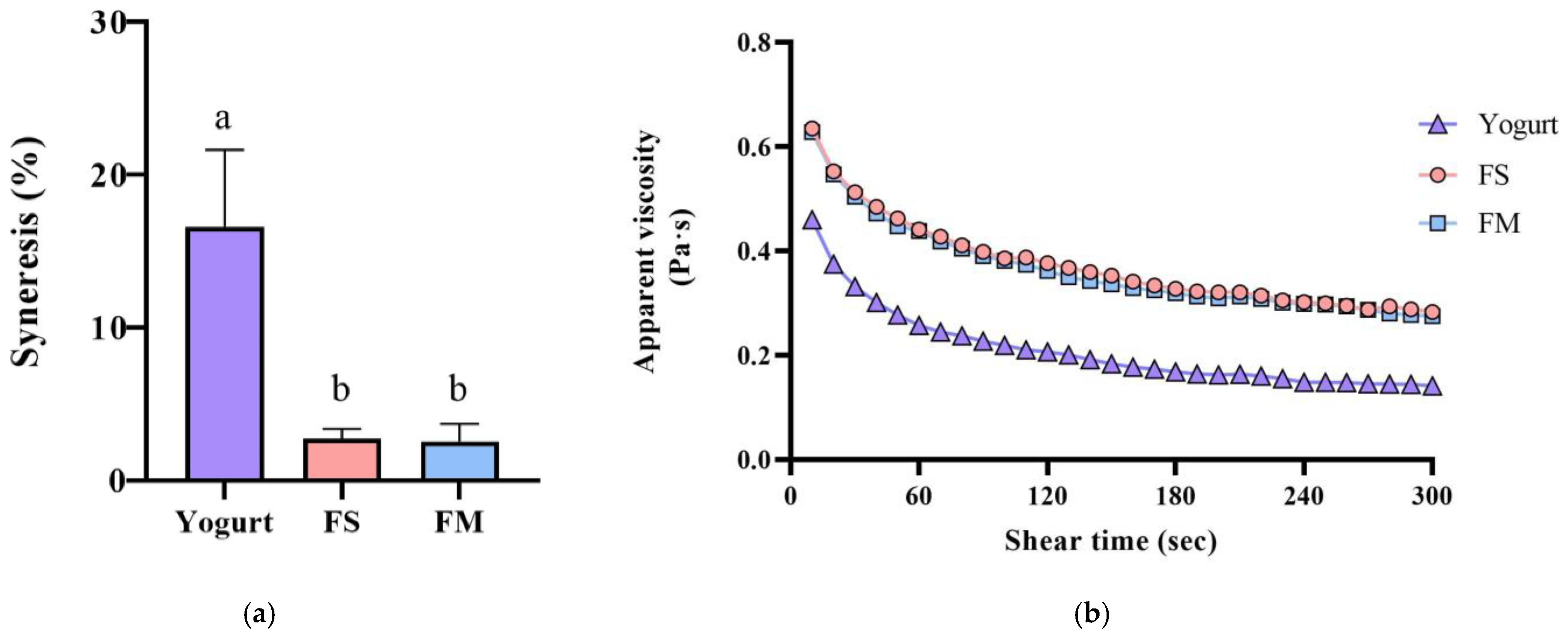
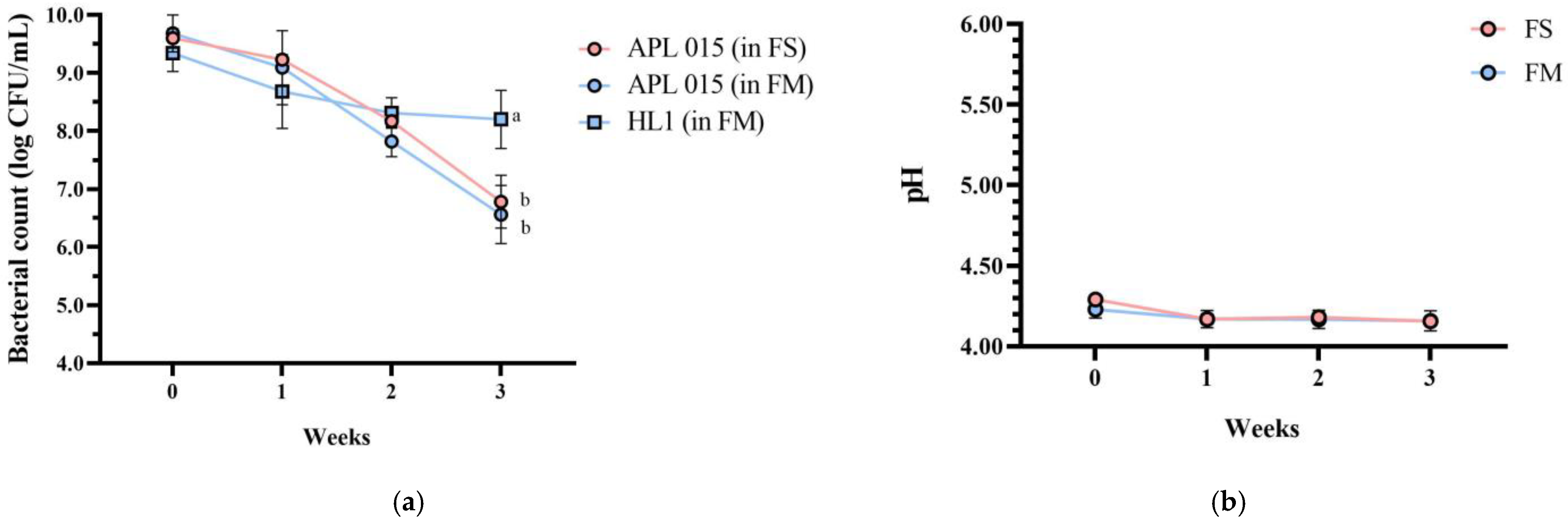
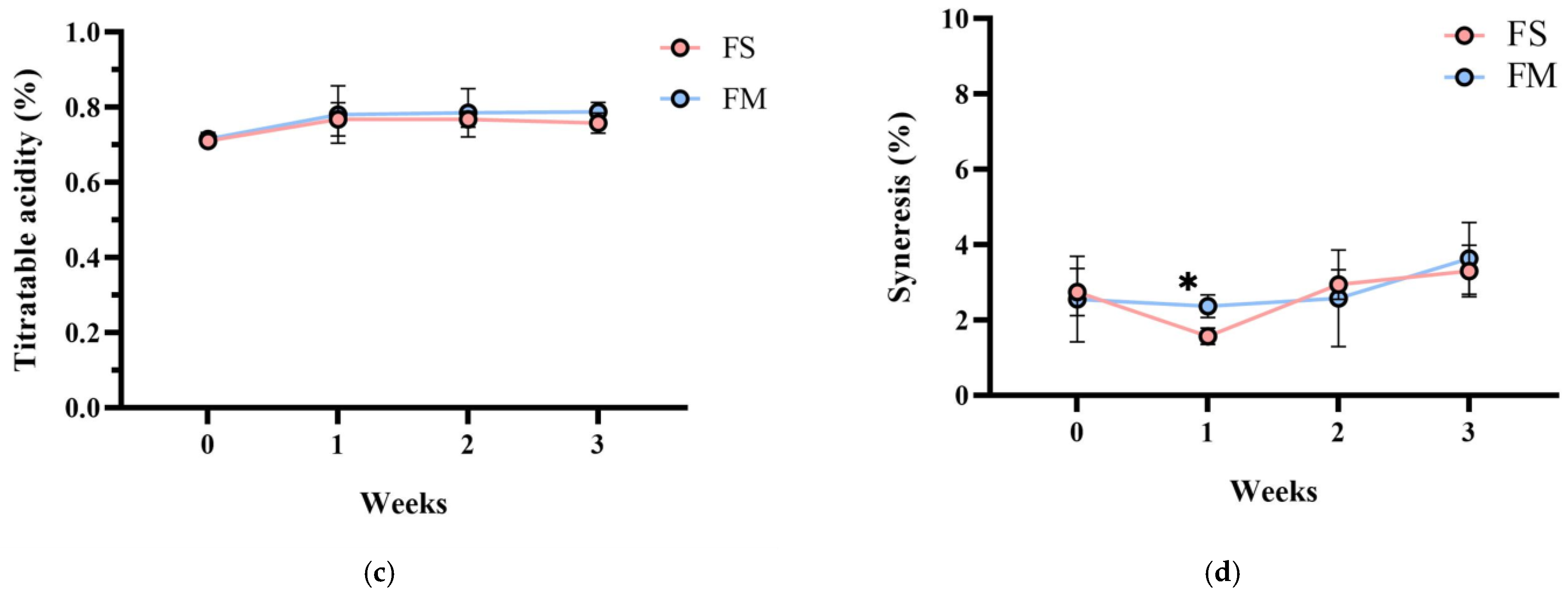


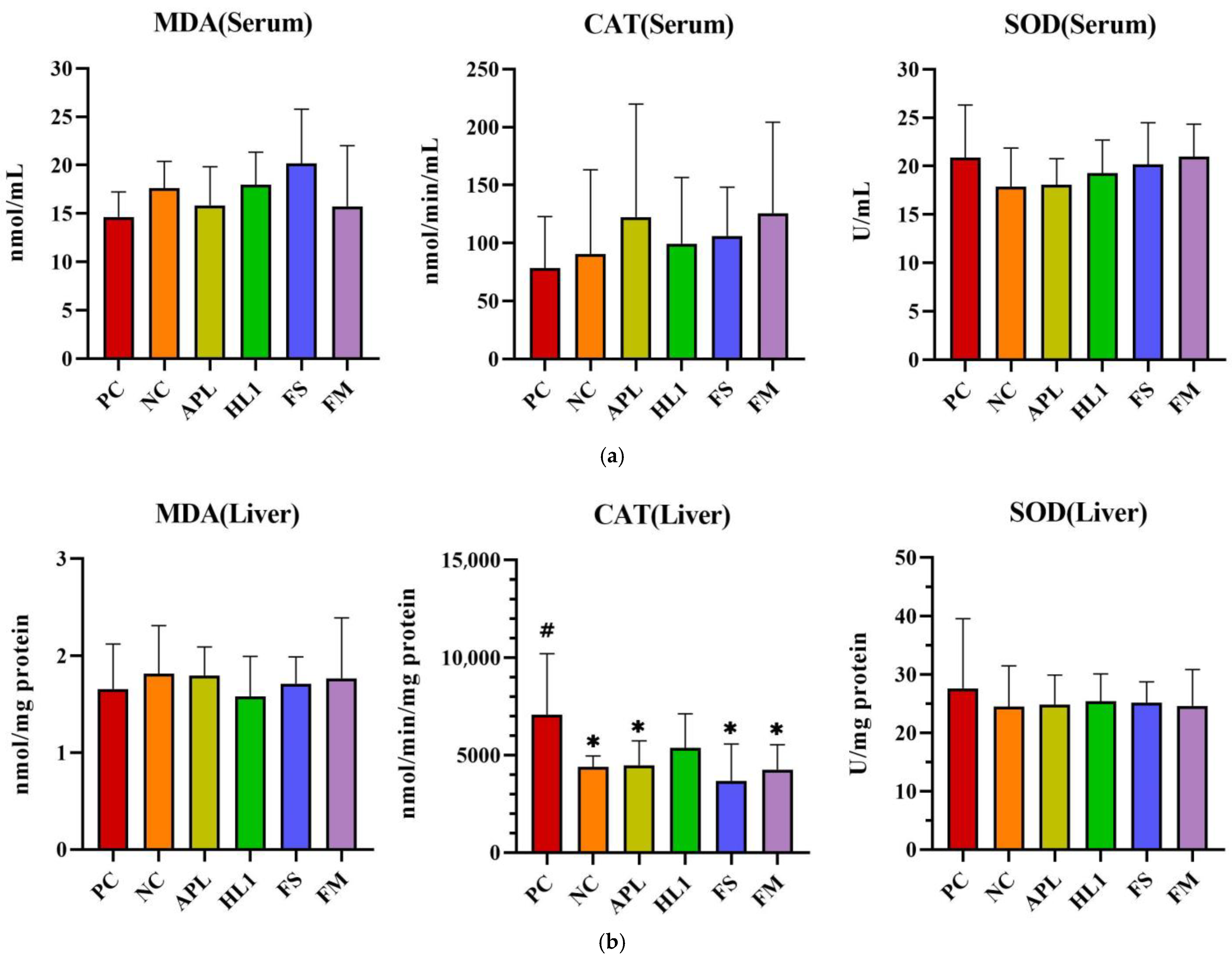

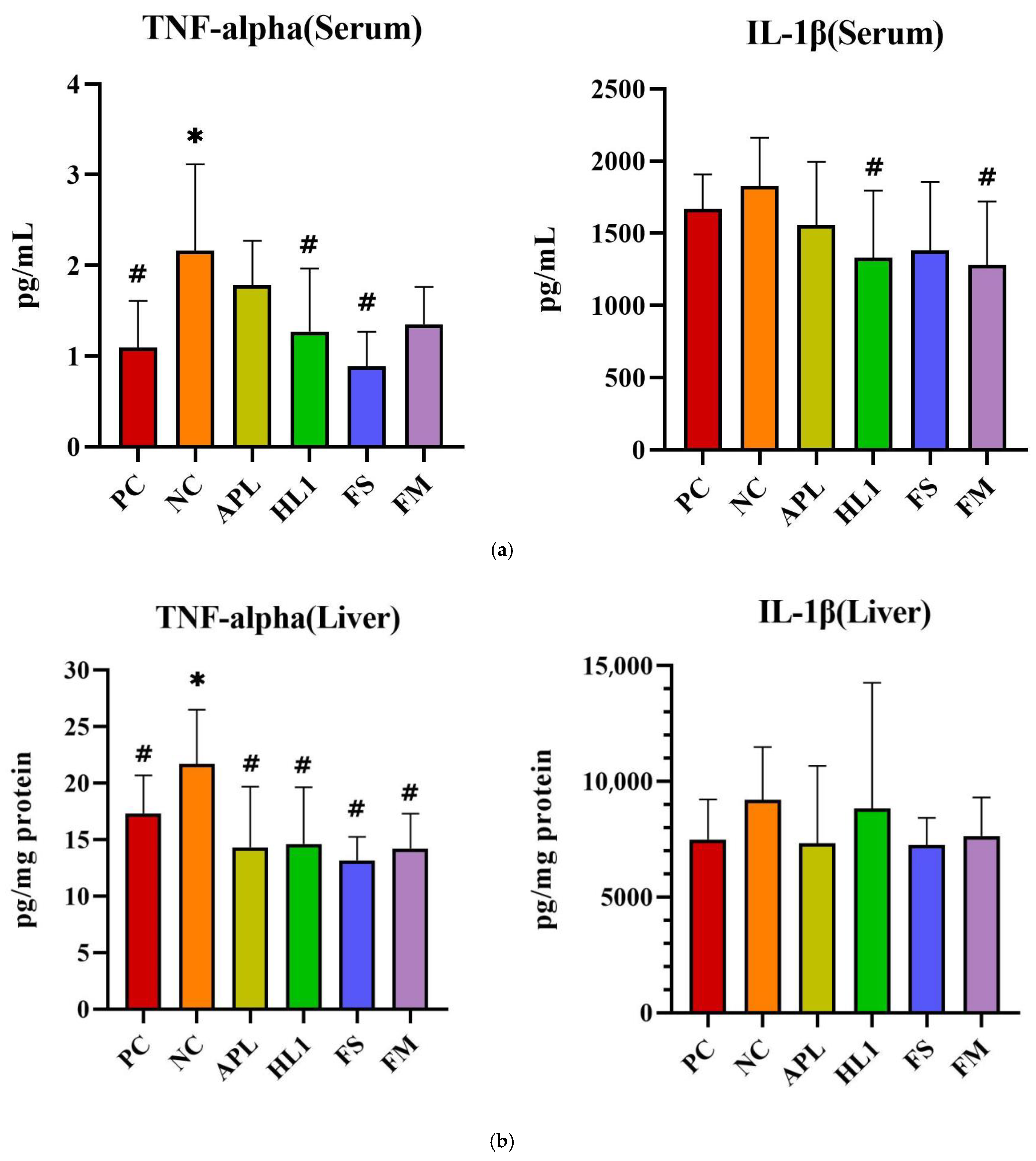
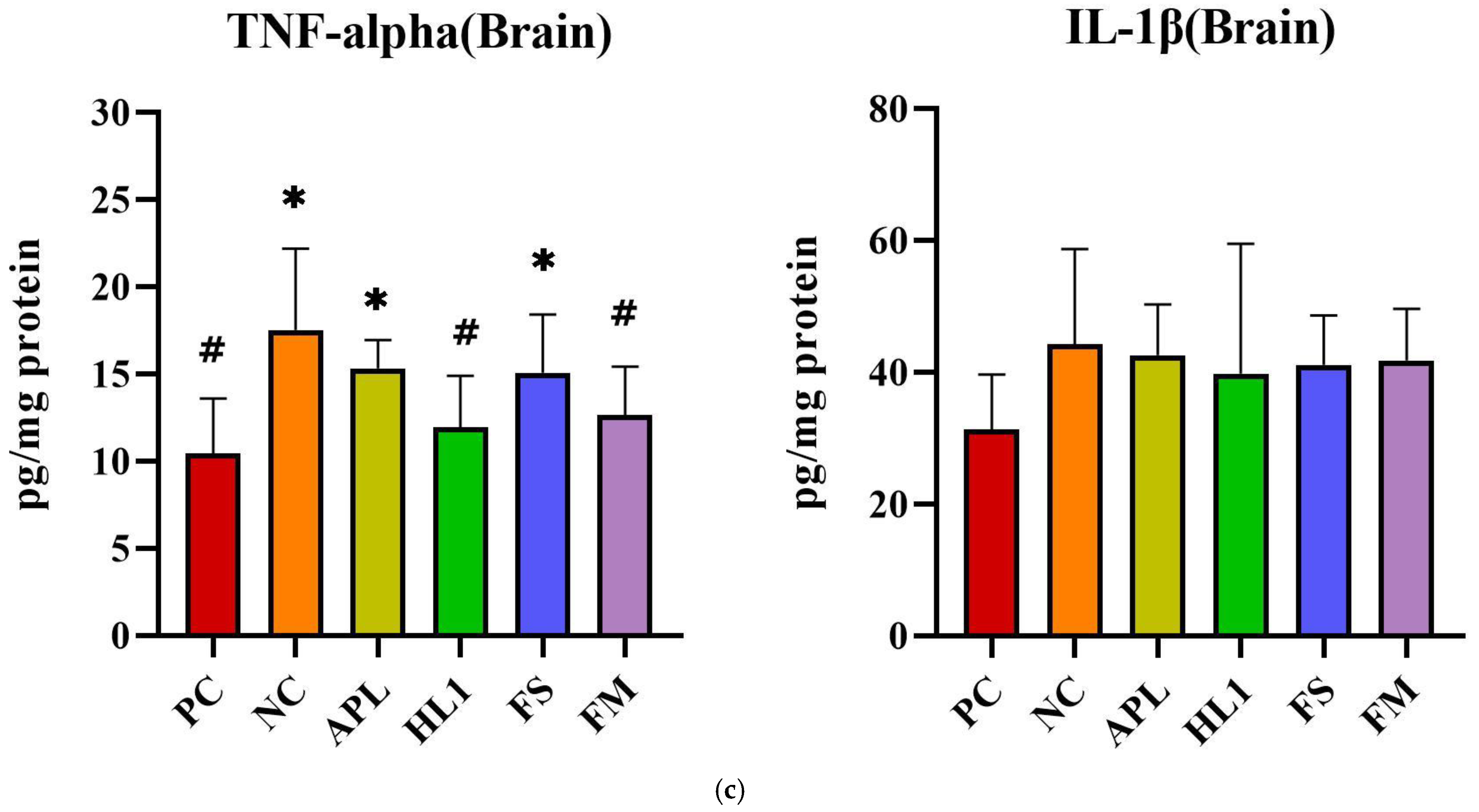
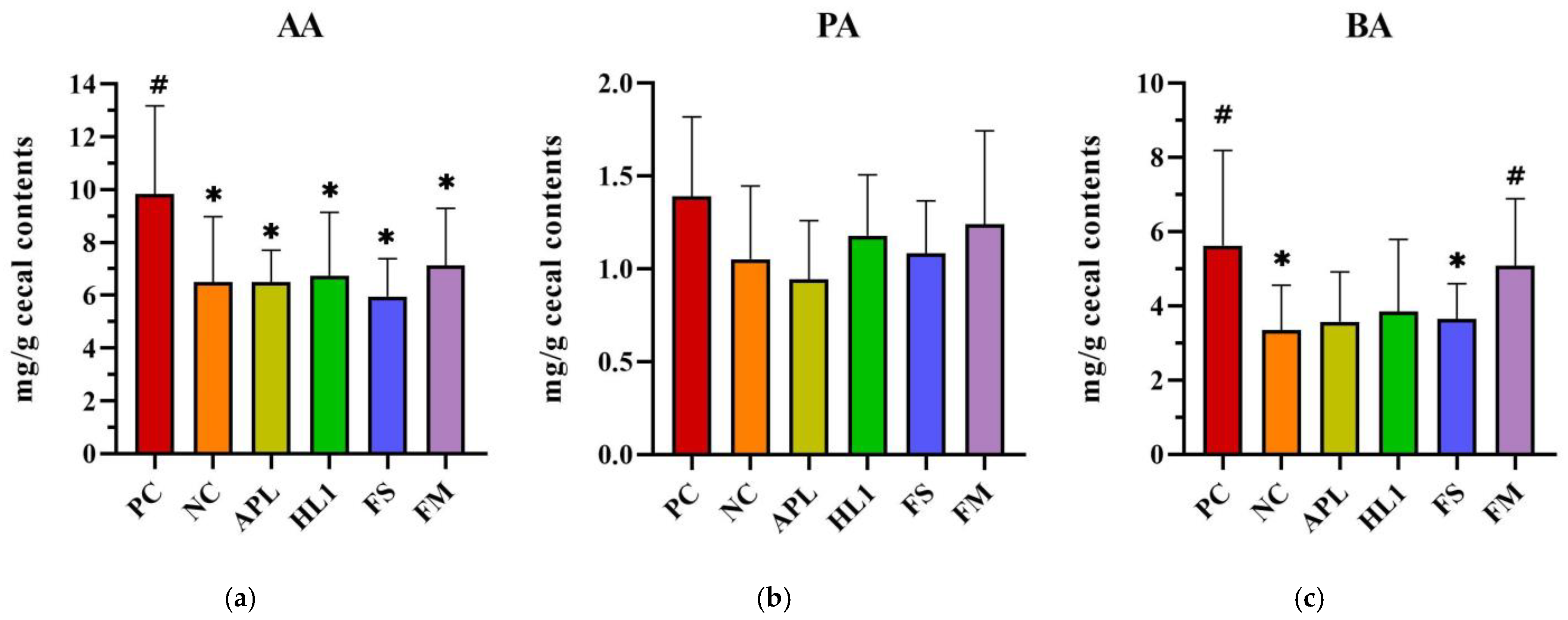

| Fermented Milk Type | Firmness (g) | Cohesiveness (g) | Consistency (g·s) | Viscosity Index (g·s) |
|---|---|---|---|---|
| Yogurt | 145.36 ± 19.29 b | 57.53 ± 4.05 | 2438.20 ± 241.34 b | 826.37 ± 72.26 |
| FS | 171.95 ± 17.05 a | 56.40 ± 5.82 | 2770.47 ± 219.75 a | 815.89 ± 49.63 |
| FM | 171.32 ± 10.65 a | 58.82 ± 4.45 | 2838.27 ± 179.20 a | 855.90 ± 31.03 |
Disclaimer/Publisher’s Note: The statements, opinions and data contained in all publications are solely those of the individual author(s) and contributor(s) and not of MDPI and/or the editor(s). MDPI and/or the editor(s) disclaim responsibility for any injury to people or property resulting from any ideas, methods, instructions or products referred to in the content. |
© 2025 by the authors. Licensee MDPI, Basel, Switzerland. This article is an open access article distributed under the terms and conditions of the Creative Commons Attribution (CC BY) license (https://creativecommons.org/licenses/by/4.0/).
Share and Cite
Wang, S.-Y.; Yen, W.-C.; Chen, Y.-P.; Shiu, J.-S.; Chen, M.-J. Developing a Novel Fermented Milk with Anti-Aging and Anti-Oxidative Properties Using Lactobacillus kefiranofaciens HL1 and Lactococcus lactis APL015. Nutrients 2025, 17, 2447. https://doi.org/10.3390/nu17152447
Wang S-Y, Yen W-C, Chen Y-P, Shiu J-S, Chen M-J. Developing a Novel Fermented Milk with Anti-Aging and Anti-Oxidative Properties Using Lactobacillus kefiranofaciens HL1 and Lactococcus lactis APL015. Nutrients. 2025; 17(15):2447. https://doi.org/10.3390/nu17152447
Chicago/Turabian StyleWang, Sheng-Yao, Wei-Chen Yen, Yen-Po Chen, Jia-Shian Shiu, and Ming-Ju Chen. 2025. "Developing a Novel Fermented Milk with Anti-Aging and Anti-Oxidative Properties Using Lactobacillus kefiranofaciens HL1 and Lactococcus lactis APL015" Nutrients 17, no. 15: 2447. https://doi.org/10.3390/nu17152447
APA StyleWang, S.-Y., Yen, W.-C., Chen, Y.-P., Shiu, J.-S., & Chen, M.-J. (2025). Developing a Novel Fermented Milk with Anti-Aging and Anti-Oxidative Properties Using Lactobacillus kefiranofaciens HL1 and Lactococcus lactis APL015. Nutrients, 17(15), 2447. https://doi.org/10.3390/nu17152447





